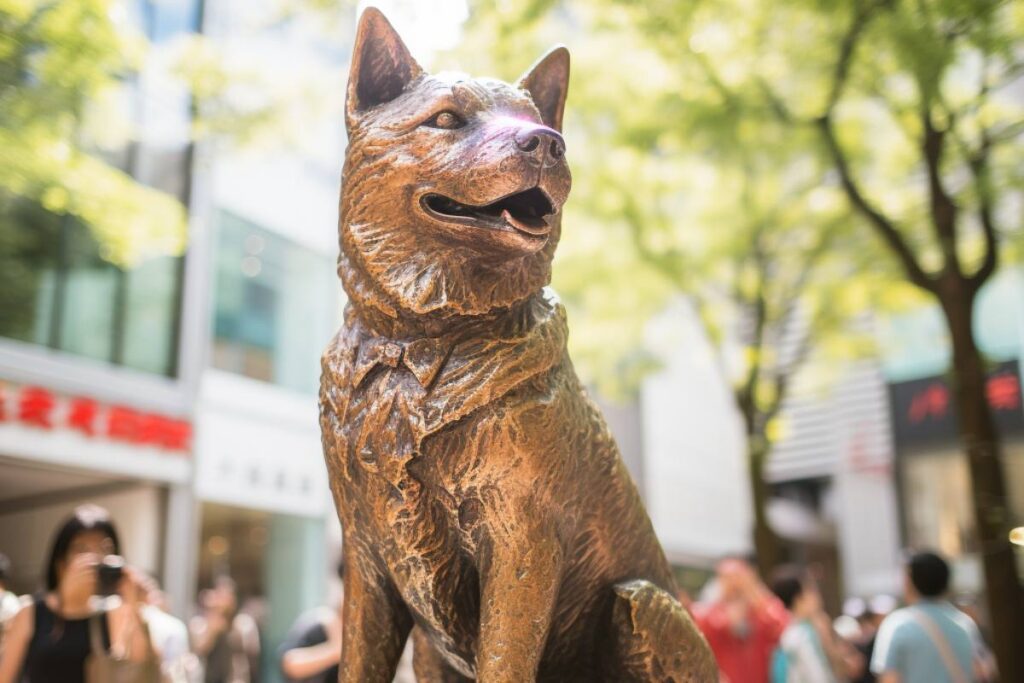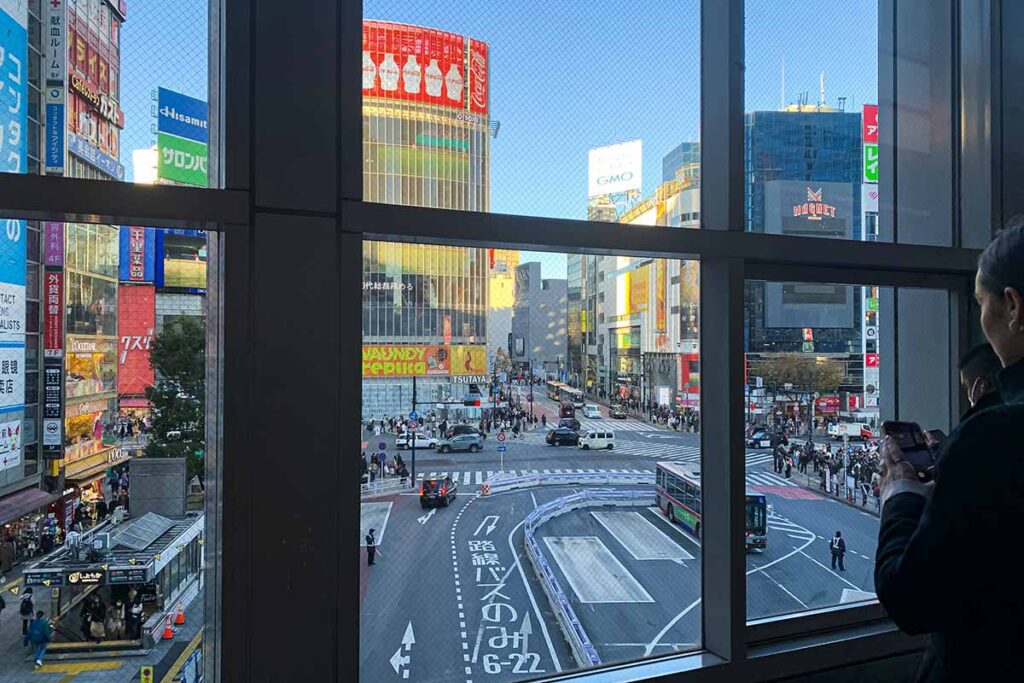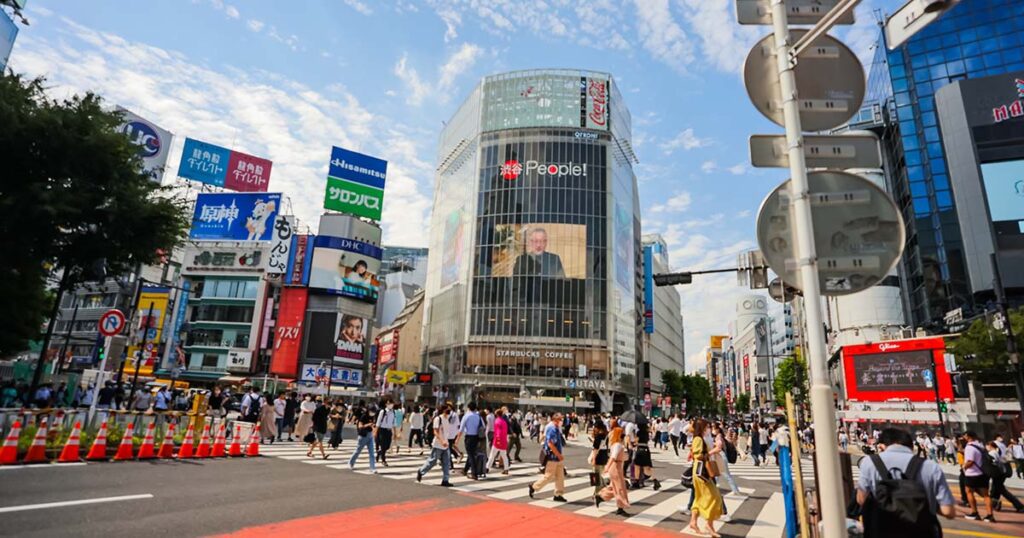Do you have experience finding yourself in a place so bustling and vibrant that it felt like the heart of the world? In Tokyo, one such place precisely fits this description: the iconic Shibuya Crossing. In this blog post, I’ll delve into the fascinating aspects of this busy intersection and why it continues to captivate locals and tourists alike.
Table of Contents
Why is Shibuya Crossing famous?
Shibuya Crossing is more than just an intersection; it’s a symbol of Tokyo’s unceasing energy and organized chaos. This expansive crosswalk, with its pulsating neon signs and giant video screens, has earned worldwide fame. It features prominently in international movies, music videos, and travel documentaries, showcasing the essence of Tokyo’s urban life.
On top of its on-screen reputation, the crossing is famous for the sheer number of people it handles. At peak times, thousands of pedestrians scramble in all directions, coming together in a mesmerizing yet orderly flurry of activity. This human ballet is a testament to Japan’s disciplined culture amidst the backdrop of an ultramodern metropolis.
Many international films and television series, such as Tokyo Drift’ ‘Fast and Furious’ and ‘Lost in Translation,’ feature this intersection, cementing its place in global pop culture.
Is Shibuya Crossing the world’s busiest crossing?
Yes, Shibuya Crossing holds the title of the world’s busiest pedestrian crossing. It’s estimated that up to 2,500 pedestrians cross at each green light, amounting to around one million people daily! This spectacle is an extraordinary sight to behold and truly encapsulates the frenetic pace of Tokyo city life.
Shibuya Crossing, right in the heart of Tokyo, Japan, holds the record as the busiest crosswalk in the world. Its strategic location near the Shibuya Station — one of Tokyo’s busiest railway stations — contributes significantly to the footfall, as commuters, shoppers, tourists, and locals crisscross through this junction day in, day out.
What is the famous intersection in Shibuya?
The famous intersection in Shibuya is none other than the Shibuya Crossing. Also known as “The Scramble,” this intersection is surrounded by iconic buildings like Shibuya 109, Shibuya Hikarie, and the Shibuya Station, each a cultural symbol in its own right.

The crossing is also a stone’s throw away from the Statue of Hachiko, the loyal dog who is a beloved figure in Japanese culture.
Which is better, Shibuya or Shinjuku?
Whether Shibuya or Shinjuku is “better” depends on your preferences, as each area offers a unique charm. Shibuya is younger and trendier, renowned for its fashion stores, nightlife, and, of course, the Shibuya Crossing. It’s a paradise for those seeking to dive into Japan’s pop culture and youth trends.
On the other hand, Shinjuku is known for its skyscrapers, government buildings, bustling shopping streets, and the tranquil Shinjuku Gyoen National Garden. It’s a fantastic mix of urban sophistication and traditional elegance.
In short, if you’re after Tokyo’s energetic, youthful vibe, Shibuya might be your pick. But on the other hand, Shinjuku could be the perfect choice for a more varied experience blending the modern and traditional.
What is the best time to see Shibuya Crossing?
While Shibuya Crossing is always buzzing with activity, the best time to see it is arguable during the evening rush hour (between 5 PM and 7 PM) when the crossing is at its busiest. The sight of the intersection filled to the brim with people, illuminated by the vibrant city lights, is simply unforgettable.
However, seeing the crossing at different times of the day offers diverse experiences. During the day, the scramble is bathed in natural light, highlighting the constant movement of people. Late at night, though quieter, the crossing is bathed in the glow of neon lights, creating a scene straight out of a cyberpunk movie.
Shibuya Crossing is more than just a means to cross the street; one must move from one side to another. It’s a living, breathing symbol of Tokyo itself.
So whether you’re a tourist making your maiden visit to Tokyo or a local who crosses it daily, the Shibuya Crossing offers a unique, quintessentially Tokyo experience that continues to fascinate, captivate, and inspire.
Where to Best View?
Shibuya Crossing, a renowned intersection in Tokyo, is best experienced from specific vantage points that offer the ‘Shibuya Crossing Best Views.’ Most of these prime viewing locations are inside various shops and cafes.
However, securing a spot in these establishments often entails a considerable wait, as tourists typically need to stay for extended periods to gain access to these sought-after seats.

Alternatively, for a unique ‘Shibuya Crossing From Above‘ perspective, the Mark City Over Bridge emerges as an excellent choice. This location is not only free of admission fees but also bypasses the lengthy waits associated with other viewing spots.
It presents an unparalleled opportunity for tourists to effortlessly capture the dynamic scene of Shibuya Crossing, without the typical delays and expenses.
Getting to Shibuya Crossing:
To get to Shibuya Crossing, one of the busiest and most famous intersections in Tokyo, Japan, you can follow these steps:
1. Take the train to Shibuya Station:
Shibuya Crossing is near Shibuya Station, one of Tokyo’s major railway stations. Take a train or bus from Narita or Haneda Airport to Shibuya Station. Depending on the airport you arrive at, various train options are available, such as the Narita Express (N’EX), Keisei Skyliner, or Tokyo Monorail. Use Google Maps or other navigation apps to find the most convenient route.
2. Exit Shibuya Station:
Once you arrive at Shibuya Station, follow the signs to the Hachiko Exit (also known as the Shibuya Mark City Exit). This is the main exit that leads directly to Shibuya Crossing.
3. Navigate to Shibuya Crossing:
As you exit the station, you’ll find yourself in the bustling streets of Shibuya. Follow the crowd towards the large intersection with multiple pedestrian crosswalks. This is Shibuya Crossing, also known as “The Scramble.” It’s hard to miss due to its size and the large video screens on surrounding buildings.
4. Train Lines you can use:
A)JR East Lines:
- Yamanote Line
- Saikyō Line
- Shōnan-Shinjuku Line
b)Tokyo Metro Lines:
- Ginza Line (G01)
- Hanzomon Line (Z01)
- Fukutoshin Line (F16)
c)Tokyu Corporation Lines:
- Tōyoko Line
- Den-en-toshi Line
d)Keio Corporation Line:
- Inokashira Line
Note: The station also serves as a terminus for many bus lines and has an extensive bus terminal above the station.
Address:
Shibuya Crossing, 2 Chome-2-1 Dogenzaka, Shibuya City, Tokyo 150-0043, Japan
